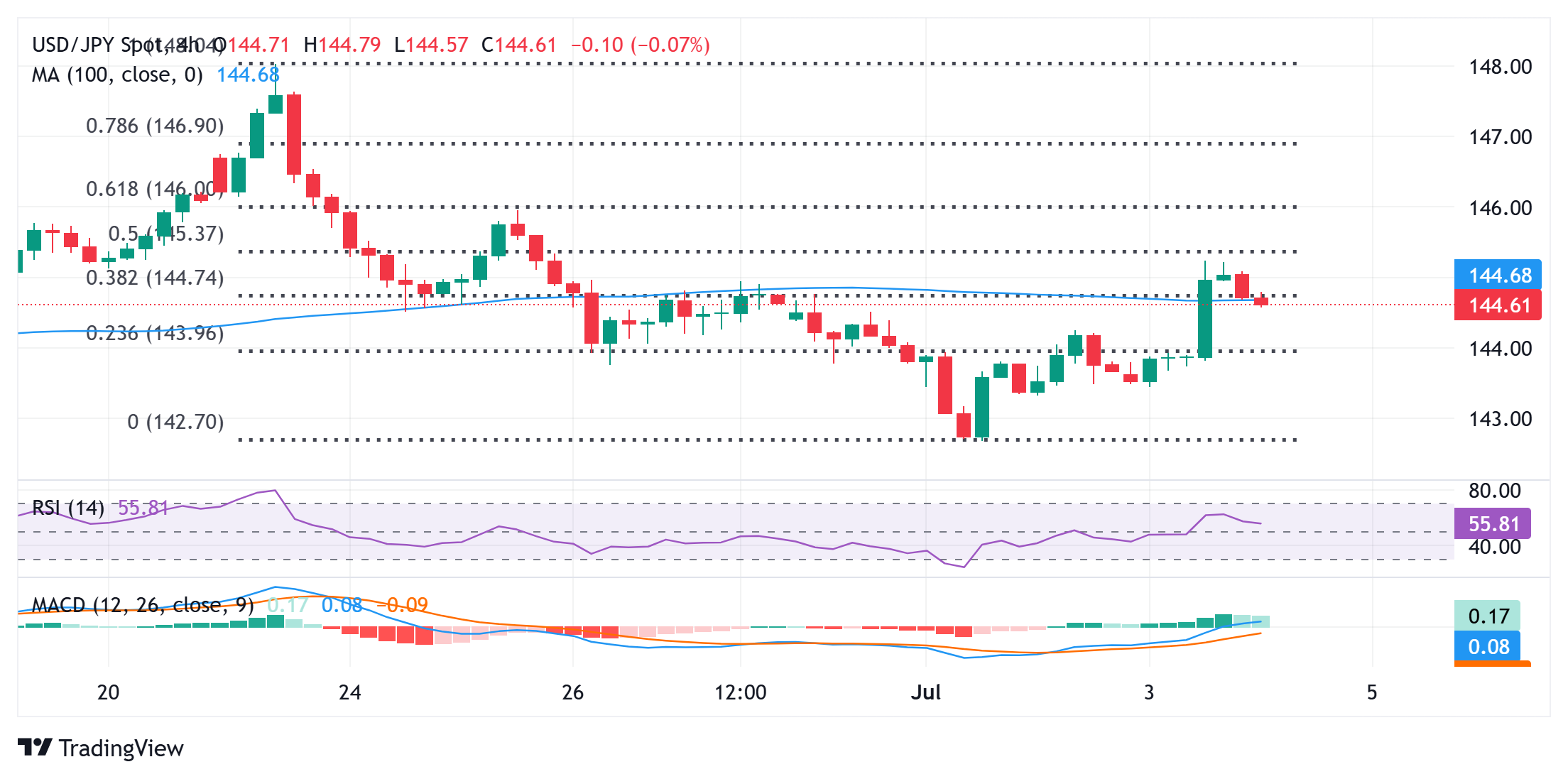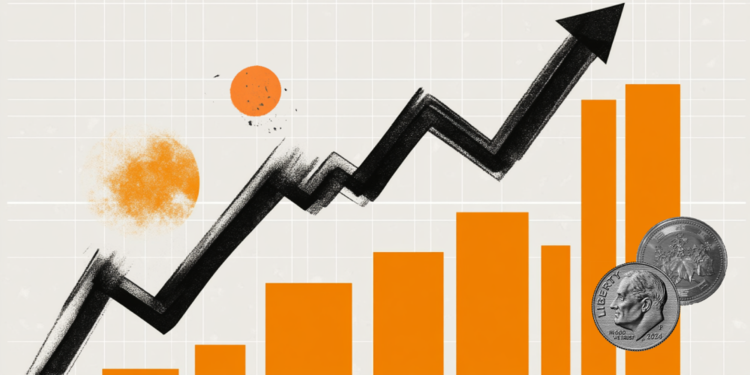- The Japanese Yen attracts buyers as the upbeat data reaffirms BoJ rate hike bets.
- US fiscal concerns undermine the USD and further weigh on the USD/JPY pair.
- The divergent BoJ-Fed expectations back the case for further losses for the pair.
The Japanese Yen (JPY) intraday buying remains unabated heading into the European session on Friday, which, along with a modest US Dollar (USD) weakness, drags the USD/JPY pair to the 144.25-144.20 area, or a fresh daily low in the last hour. Strong Household Spending data released earlier today from Japan revives Bank of Japan (BoJ) rate hike bets and boosts the JPY. Apart from this, the uncertainty over US President Donald Trump’s policies further benefits the safe-haven JPY.
Meanwhile, investors remain worried that trade tensions triggered by Trump’s threat to impose more tariffs on Japan, over its alleged unwillingness to buy American-grown rice, could complicate the BoJ’s efforts to normalise monetary policy. Apart from this, the prevalent risk-on environment might contribute to capping further gains for the JPY. Traders might also refrain from placing aggressive directional bets amid the expected thin liquidity on the back of the Independence Day holiday in the US.
Japanese Yen bulls retain intraday control amid hawkish BoJ expectations
- The US Bureau of Labor Statistics (BLS) reported on Thursday that the economy added 147,000 new jobs in June compared to the previous month’s upwardly revised reading of 144,000 and the 110,000 expected. Moreover, the Unemployment Rate edged lower to 4.1% from 4.2% in May and pointed to a still resilient US labor market.
- The topline beat gives the Federal Reserve space to stick to its wait-and-see approach amid the uncertainty stemming from US President Donald Trump’s trade policies. This, in turn, pushed the US Dollar (USD) and the USD/JPY pair to a fresh weekly high, though the momentum lacked strong follow-through or bullish conviction.
- Additional details revealed that annual wage inflation growth, as measured by the change in the Average Hourly Earnings, retreated to 3.7% from 3.8% in May. This was short of the analysts’ estimate of a 3.9% rise. This, along with concerns about the worsening US fiscal condition, contributes to capping the upside for the buck.
- US President Donald Trump’s tax-cut and spending bill cleared its final hurdle in Congress on Thursday, averting the near-term prospect of a US government default. The legislation would explode the federal deficit as it is estimated to add $3.4 trillion to the nation’s debt over the next decade. This would make America’s long-term debt problems even worse and hold back the USD bulls from placing aggressive bets, capping the USD/JPY pair.
- Meanwhile, the Japanese Yen attracts some buying during the Asian session on Friday after a government report showed that Household Spending surpassed even the most optimistic estimates and rose 4.7% in May from a year earlier. The upbeat data reignites speculation of near-term interest rate hikes by the Bank of Japan.
- In contrast, traders still see a greater chance that the Fed will resume its rate-cutting cycle in September and lower borrowing costs by at least 50 basis points by the end of this year. This contributes to the USD/JPY pair’s slide, though trade uncertainties might hold back traders from placing aggressive directional bets.
USD/JPY bears might await a break below 144.00 before placing fresh bets

The overnight breakout through the 144.65-144.70 confluence – comprising the 100-period Simple Moving Average (SMA) on the 4-hour chart and the 38.2% Fibonacci retracement level of the June-July downfall – was seen as a key trigger for the USD/JPY bulls. However, failure near the 145.25 supply zone, which nears the 50% retracement level, and the subsequent pullback warrant some caution before positioning for any meaningful upside.
Meanwhile, any further slide is likely to find some support near the 144.20 horizontal zone ahead of the 144.00 round figure, or the 23.6% Fibo. retracement level. A convincing break below the latter might shift the bias back in favor of bearish traders and drag the USD/JPY pair to the 143.45 intermediate support en route to the 143.00 mark. The downward trajectory could extend further towards the 142.70-142.65 region, or a one-month low touched on Tuesday.
On the flip side, the 145.00 psychological mark might now act as an immediate hurdle ahead of the 145.25-145.30 zone. Some follow-through buying should allow the USD/JPY pair to test the 61.8% Fibo. retracement level and conquer the 146.00 round figure.
Japanese Yen FAQs
The Japanese Yen (JPY) is one of the world’s most traded currencies. Its value is broadly determined by the performance of the Japanese economy, but more specifically by the Bank of Japan’s policy, the differential between Japanese and US bond yields, or risk sentiment among traders, among other factors.
One of the Bank of Japan’s mandates is currency control, so its moves are key for the Yen. The BoJ has directly intervened in currency markets sometimes, generally to lower the value of the Yen, although it refrains from doing it often due to political concerns of its main trading partners. The BoJ ultra-loose monetary policy between 2013 and 2024 caused the Yen to depreciate against its main currency peers due to an increasing policy divergence between the Bank of Japan and other main central banks. More recently, the gradually unwinding of this ultra-loose policy has given some support to the Yen.
Over the last decade, the BoJ’s stance of sticking to ultra-loose monetary policy has led to a widening policy divergence with other central banks, particularly with the US Federal Reserve. This supported a widening of the differential between the 10-year US and Japanese bonds, which favored the US Dollar against the Japanese Yen. The BoJ decision in 2024 to gradually abandon the ultra-loose policy, coupled with interest-rate cuts in other major central banks, is narrowing this differential.
The Japanese Yen is often seen as a safe-haven investment. This means that in times of market stress, investors are more likely to put their money in the Japanese currency due to its supposed reliability and stability. Turbulent times are likely to strengthen the Yen’s value against other currencies seen as more risky to invest in.

